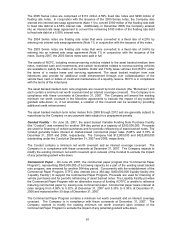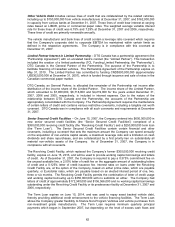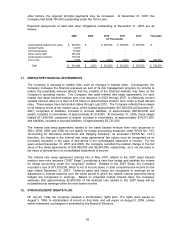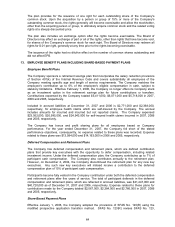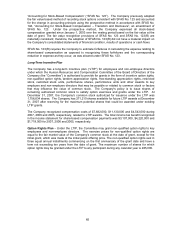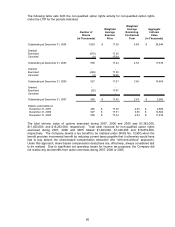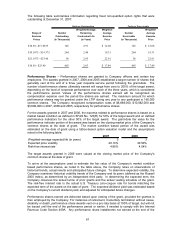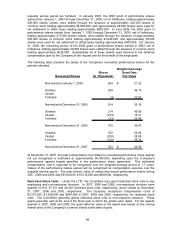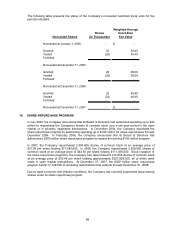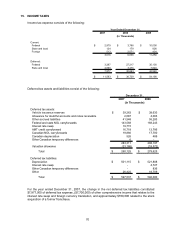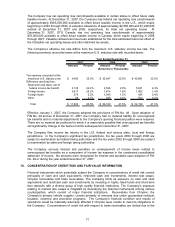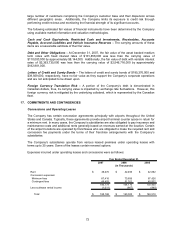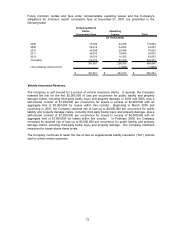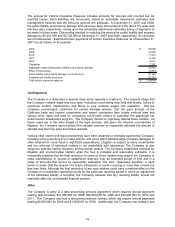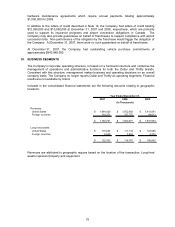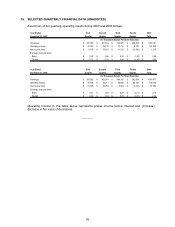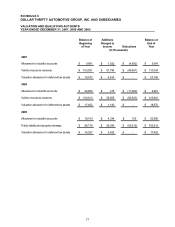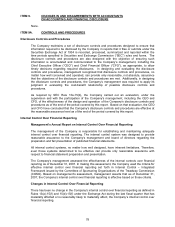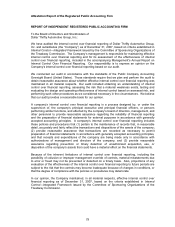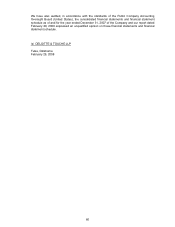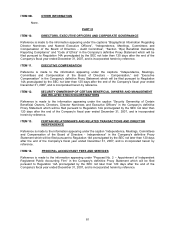Thrifty Car Rental 2007 Annual Report Download - page 79
Download and view the complete annual report
Please find page 79 of the 2007 Thrifty Car Rental annual report below. You can navigate through the pages in the report by either clicking on the pages listed below, or by using the keyword search tool below to find specific information within the annual report.
The Company has net operating loss carryforwards available in certain states to offset future state
taxable income. At December 31, 2007, the Company has federal net operating loss carryforwards
of approximately $365,000,000 available to offset future taxable income in the U.S., which expire
beginning in 2023 through 2024. A valuation allowance of approximately $2,800,000 and $1,200,000
existed at December 31, 2007 and 2006, respectively, for state net operating losses. At
December 31, 2007, DTG Canada has net operating loss carryforwards of approximately
$70,000,000 available to offset future taxable income in Canada, which expire beginning in 2008
through 2027. Valuation allowances have been established for the total estimated future tax effect of
the Canadian net operating losses and other deferred tax assets.
The Company’s effective tax rate differs from the maximum U.S. statutory income tax rate. The
following summary reconciles taxes at the maximum U.S. statutory rate with recorded taxes:
Amount Percent
A
mount Percent Amount Percent
(Amounts in Thousands)
Tax expense computed at the
maximum U.S. statutory rate 4,483$ 35.0% 30,947$ 35.0% 45,691$ 35.0%
Difference resulting from:
State and local taxes, net of
federal income tax benefit 3,130 24.4% 2,528 2.9% 5,631 4.3%
Foreign losses 3,617 28.2% 1,614 1.8% 1,892 1.4%
Foreign taxes 275 2.2% 1,345 1.5% 424 0.4%
Other 88 0.7% 295 0.3% 552 0.4%
Total 11,593$ 90.5% 36,729$ 41.5% 54,190$ 41.5%
Year Ended December 31,
2007 2006 2005
Effective January 1, 2007, the Company adopted the provisions of FIN No. 48. Upon adoption of
FIN No. 48 and as of December 31, 2007, the Company had no material liability for unrecognized
tax benefits and no material adjustments to the Company’s opening financial position were required.
There are no material tax positions for which it is reasonably possible that unrecognized tax benefits
will significantly change in the twelve months subsequent to December 31, 2007.
The Company files income tax returns in the U.S. federal and various state, local and foreign
jurisdictions. In the Company’s significant tax jurisdictions, the tax years 2004 through 2006 are
subject to examination by federal taxing authorities and the tax years 2002 through 2006 are subject
to examination by state and foreign taxing authorities.
The Company accrues interest and penalties on underpayment of income taxes related to
unrecognized tax benefits as a component of income tax expense in the condensed consolidated
statement of income. No amounts were recognized for interest and penalties upon adoption of FIN
No. 48 or during the year ended December 31, 2007.
16. CONCENTRATION OF CREDIT RISK AND FAIR VALUE INFORMATION
Financial instruments which potentially subject the Company to concentrations of credit risk consist
principally of cash and cash equivalents, restricted cash and investments, interest rate swaps,
Chrysler receivables and trade receivables. The Company limits its exposure on cash and cash
equivalents and restricted cash and investments by investing in highly rated funds and short-term
time deposits with a diverse group of high quality financial institutions. The Company’s exposure
relating to interest rate swaps is mitigated by diversifying the financial instruments among various
counterparties, which consist of major financial institutions. Receivables from Chrysler, the
Company's primary vehicle supplier, consist primarily of amounts due under guaranteed residual,
buyback, incentive and promotion programs. The Company’s financial condition and results of
operations would be materially adversely affected if Chrysler were unable to meet its obligations to
the Company. Concentrations of credit risk with respect to trade receivables are limited due to the
71


